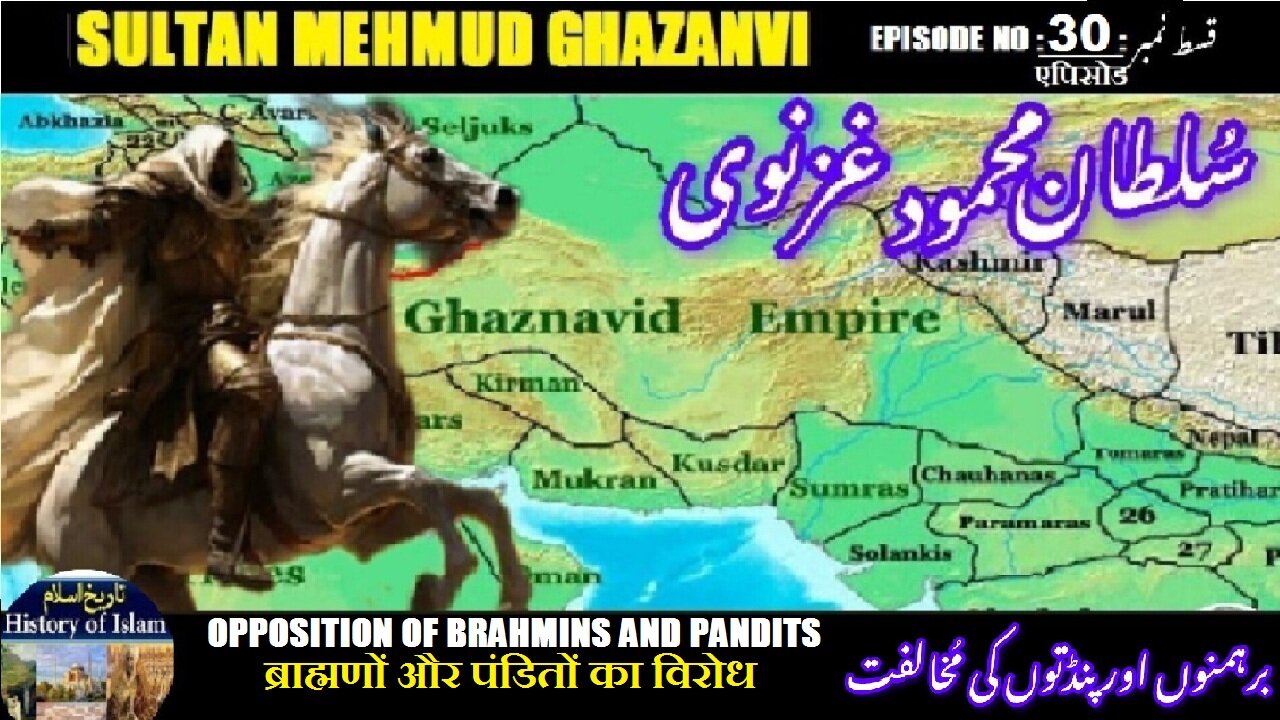Premium Only Content

Sultan Mehmud Ghazanvi Episode-30-एपिसोड Brahmins and Pandits विपक्ष برہمنوں اور پنڈتوں کی مخالفت
@islamichisory813 #islamichistory #islamicwarriorleader #sultanmahmudghaznvi #series, #warriorking #idolbreaker #biography #achievements #warriorhistory #inspiringlegends #épisode30
Sultan Mehmud Ghazanvi Episode-30-एपिसोड Brahmins and Pandits विपक्ष برہمنوں اور پنڈتوں کی مخالفت
Asslamoalaikum, We Welcome in our series dedicated to the remarkable life of Islamic warrior leader Sultan Mehmud Ghazanvi. Each episode will provide insight into his life, highlighting the values and principles that have defined his legacy.
Sultan Mahmud Ghaznvi, the idol-breaker, is a shining star in Islamic history of whom the Muslims of the subcontinent can truly be proud. Under extremely difficult circumstances, he laid the first brick of Islam in the region by carrying out seventeen attacks on the Somnath temple, a symbol of Hindu pride in the subcontinent. Bigoted Hindus and others try to portray Sultan Mahmud Ghazni as a robber and looter in their books. Although in his view, the promotion of Islam was more important than wealth.If we take a closer look at his live, the truth becomes clear.
Through a conspiracy, the history of Muslim heroes in the subcontinent is being erased from social sciences, history and geography, which is a very scary trend because it will make our young generation forget the hard work and success of our heroes.
Sultan Mahmud Ghaznvi was born on Nov. 2, 971, Yamin ad-Dawlah Abdul-Qasim Mahmud ibn Sabuktegin, better known as Mahmud of Ghazni, was born in the town of Ghazni, in southeast Afghanistan. His father Abu Mansur Sabuktegin was Turkic, a former Mamluk enslaved warrior from Ghazni.
When the Samanid dynasty, based in Bukhara began to crumble, Sabuktegin seized control of his hometown of Ghazni in 977. He then conquered other major Afghan cities, such as Kandahar. His kingdom formed the core of the Ghaznavid Empire, and he is credited with founding the dynasty.
On his deathbed, Sabuktegin passed over his militarily and diplomatically skilled eldest son Mahmud, 27, in favor of the second son, Ismail. It seems likely that he chose Ismail because he was not descended from enslaved people on both sides, unlike the elder and younger brothers.
When Mahmud, who was stationed at Nishapur, heard of his brother's appointment to the throne, he immediately marched east to challenge Ismail's right to rule. Mahmud overcame his brother's supporters in 998, seized Ghazni, took the throne for himself, and placed his younger brother under house arrest for the rest of his life.
By 1001, Mahmud had turned his attention to the fertile lands of the Punjab, now in India, which lay southeast of his empire. The target region belonged to fierce but fractious Hindu Rajput kings, who refused to coordinate their defense against the Muslim threat from Afghanistan. In addition, the Rajputs used a combination of infantry and elephant-mounted cavalry, a formidable but slower-moving form of army than the Ghaznavids' horse cavalry.
Over the next three decades, Mahmud of Ghazni would make more than a dozen military strikes into Hindu and Ismaili kingdoms to the south. By the time of his death, Mahmud's empire stretched to the shores of the Indian Ocean at southern Gujarat.
In 1026, the 55-year-old sultan set out to invade the state of Kathiawar, on India's west (Arabian Sea) coast. His army drove as far south as Somnath.
Although Mahmud's troops successfully captured Somnath and destroying , there was troubling news from Afghanistan. A number of other Turkic tribes had risen up to challenge Ghaznavid rule, including the Seljuk Turks, who had already captured Merv (Turkmenistan) and Nishapur (Iran). These challengers had already begun to nibble away at the edges of the Ghaznavid Empire by the time Mahmud died.
His empire would survive until 1187, although it began to crumble from west to east even before his death. In 1151, the Ghaznavid sultan Bahram Shah lost Ghazni itself, fleeing to Lahore (Pakistan).
The Sultan Mahmud spent much of his life battling against what he called "infidels"—Hindus, Jains, Buddhists, and Muslim splinter-groups such as the Ismailis. In fact, the Ismailis seem to have been a particular target of his wrath, since Mahmud (and his nominal overlord, the Abbasid caliph) considered them heretics.
Sultan Mehmed II's conquest which led to the fall of the Byzantine Empire was prophesied by the Prophet Muhammad ? in his famous narration (hadith): “Verily you shall conquer Constantinople. What a wonderful leader will he be, and what a wonderful army will that army be!"
On 30 April 1030 Sultan Mahmud died in Ghazni at the age of 58. Sultan Mahmud had contracted malaria during his last invasion.
So, starting tomorrow, we will be presented you with videos based on the biography, conquests, and his life of Sultan Mahmud Ghaznavi on a daily basis at this same time. Hope you will enjoy our all informative videos.
.
Allah Hafiz
-
 7:00
7:00
ISLAMIC HISTORY
5 hours agoBiography of Islamic Scholar Al-Saghani اسلامی اسکالر الصغانی کی سوانح حیات
2 -
 LIVE
LIVE
Kim Iversen
41 minutes agoWho Let This Happen??: Israel Now Controls Tik Tok, CBS News, HBO, MTV and More
382 watching -
 LIVE
LIVE
Dr Disrespect
5 hours ago🔴LIVE - DR DISRESPECT - BLACK OPS 7 - GIVE ME BACK MY NUKE
1,347 watching -
 1:30:22
1:30:22
Tucker Carlson
4 hours agoEverything You Should Know About Dan Crenshaw, How He Got Rich & Why He’s So in Love With Ukraine
19.8K50 -
 1:11:41
1:11:41
vivafrei
3 hours agoLawless in Chicago! Mayor Signs EO Bannin ICE! Press Sec Drops Truth Bomb on Shutdown! & MORE!
55.8K42 -
 DVR
DVR
The Trish Regan Show
1 hour agoBREAKING: Trump Announces “Dividend Checks” for All Americans… for A LOT Of Money!!
1.7K4 -
 22:28
22:28
Fit'n Fire
1 day ago $0.04 earnedDid This Rifle Just Replace the Anderson AM15?
1222 -
 LIVE
LIVE
freecastle
5 hours agoTAKE UP YOUR CROSS- Though I sit in darkness, the LORD will be my light!
39 watching -
 LIVE
LIVE
LFA TV
21 hours agoLIVE & BREAKING NEWS! | MONDAY 10/6/25
1,615 watching -
 1:43:38
1:43:38
The Quartering
3 hours agoWar In The Streets & How Bad Will It Get?
81.1K32
